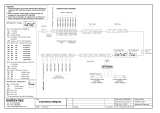
Introduction to the Crane
Crane | 14
1.3 FREQUENCY INVERTER USE ADVANTAGES
We are able to evaluate the advantages of the variable frequency inverter use for crane vertical or horizontal
motion or for crane horizontal motion, under the following aspects:
■
Elimination of the electrical line disturbances:
with the use of the inverter, by maintaining the motor flux
constant (varying both frequency and voltage), it is possible to have the motor rated torque in the entire speed
range.
Therefore, with the inverter it becomes possible to start high torque loads with currents that are close to
motor rated current thus eliminating the high direct on line motor starting currents (up to 7 x In). The frequency
inverter eliminates those effects that cause voltage sags, the need of over sizing the switchgear, cables and
transformers, avoiding nuisance trips, etc.;
■
Elimination of the mechanical stress:
frequency inverters allow the programming of soft acceleration and
deceleration ramps, still giving out high torque, eliminating mechanical stress while starting, during speed
changes (if compared to the commutations of slip ring motor resistances), and while stopping, since the
mechanical brake does not longer engage for regular stopping (braking becomes electrical), being used only for
parking and emergencies. In this way downtime due to maintenance, adjustment of brake shoes, due to broken
coupling, bearings or gearboxes, is drastically reduced. Easier load positioning and better precision are also
achieved. All the settings are programmable and can be easily changed according to the application
requirements (acceleration and deceleration ramps, speeds, etc.);
■
there is a reduction in the energy consumption because the motor power (kW) is
determinated by the driven load and by the operation speed, consuming only what the process requires,
eliminating energy wastes (low efficiency, energy and heat dissipation at slip ring motor drive systems), etc.
In
production overhead cranes with high duty cycles, the use of active front end frequency inverters (regenerative)
becomes feasible, making it possible, besides the above mentioned energy savings for the return to the line of
the energy regenerated by lowering and braking the load (when the motor is being driven and operates as a
generator);
■
the frequency inverter makes the system automation possible by allowing the control
through communication networks. By exchanging information with a higher hierarchy system (PLC, supervisory),
it allows better process management through monitoring, report emission, etc. It also makes the adaptation to a
remote radio control, with pushbuttons or joystick, easier;
■
it makes the use of standard induction motors possible, facilitating the plant motor
standardization, for maintenance and spares availability;
■
the reduction of mechanical noises and vibrations improve operator and area personnel comfort,
safety and productivity.
1.4 PRECAUTIONS IN THE FREQUENCY INVERTER SELECTION
For the great majority of loads (pumps, fans, compressors, etc. ) the frequency inverter selection is made
through the electric motor rated current, using an inverter with equal or slightly higher rated current (for
environmental conditions: temperature up to 50 °C and altitude up to 1000 m).
This selection also considers 150 % overload during 60 s every 10 minutes for heavy duty (HD) loads, or 110 %
overload during 60 seconds every 10 minutes for normal duty (ND) loads.
For crane applications, where there is need of starting heavy loads with relatively short acceleration times, it is
certain that the inverter has to operate with overload to overcome the inertia during acceleration or deceleration,
and normally the duty cycle is higher than the supported by the regular overload capability of frequency
inverters.
Therefore, in most of cases, it is necessary to take into account the worst-case duty cycle for a 10-
minute operation period, calculating the rms current value for that period.
The chosen inverter will be for a current equal or higher than the calculated rms value. It must also be observed
whether any overload current in the evaluated cycle is higher than 1.5 times the rated inverter current, where the
inverter must be oversized in order to fulfill this requirement.






















